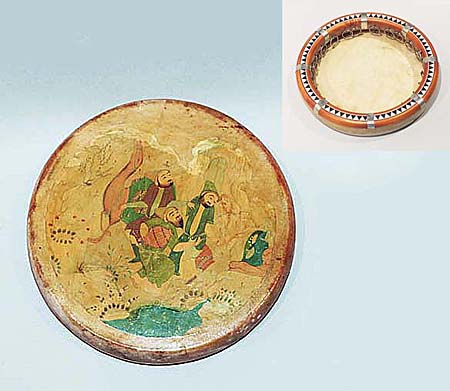
Owner: HWMC
Catalog#: 2AS-MBST-09
Provenance: Robert Massaro Collection
Struck Membranophones
Uzbekistan ‘Doyra’ (Drum)
Uzbekistan
Uzbek
Wood, cowhide, metal, lacquer, bone, acrylic
Early-Mid 20th century
Diameter: 9 in, Frame width: 1 in, Frame depth: 1.8 in
Membranophones – Struck Membranophones
The Uzbekistan doyra (doira) drum is a traditional instrument that can be found across Central Asia. In each country there are slight variations. Some countries call it duff, riq, ghaval etc. It is now a major instrument in musical performances in Uzbekistan, where it is called and known as doyra. Originally it was played by women at weddings, then at the end of the 18th century, men became the dominant players which changed the doyra into a little smaller and heavier instrument, used for dances. It can even serve as a solo instrument today.
This Uzbek doyra, a single-headed frame drum, has a heavy wooden frame with cow skin stretched over the frame and attached with metal fastenings and glue. Painted on the drumhead is a landscape scene of three men collecting water at a stream with a camel. The art is lacquered directly onto the drumhead. Along the rim inside are 24 heavy metal rings that add to the sound. The rim of the frame is also decorated with a tessellated ring of black and white triangles made of acrylic and bone. To play the doyra, you hold the rim of the drum with one hand and beat with both hands using the fingers. Often, they attach a piece of rope that can be placed around the thumb to help hold the doyra.
Resource: The Fifth Floor – Doyra: The Drum of Uzbekistan – BBC Sounds: An interview with Abbos Kosimov the maestro of the doyra.
